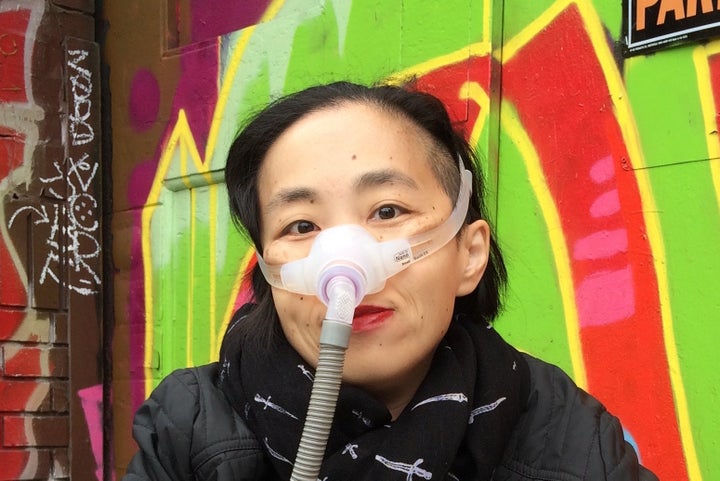When Alice Wong was growing up in 1980s Indiana, she “always felt like the odd person out.” She was one of just a few Asian-Americans in her school and the only student with physical disabilities.
“In many ways, not seeing myself represented or reflected in my social environment was the norm. I never thought it was odd,” Wong says.
Wong, 44, has a form of muscular dystrophy called spinal muscular atrophy, characterized by progressive muscle atrophy and weakness. As a young child, she could walk with the aid of a walker, but by the age of 7, that felt too exhausting, and she started using a wheelchair. In a time before the Americans with Disabilities Act was law, she remembers receiving physical therapy and riding to school in a wheelchair-accessible bus, but generally it was difficult for her to obtain services or accommodations for her disability.
“I don’t recall anyone asking me about my needs and wants,” she says. Looking back, she thinks her immigrant parents could have taken a more active role in advocating for her, but they were unfamiliar with how to navigate the system and did the best they could. This, she believes, prompted her to start advocating for herself at a young age.
As a graduate student at the University of California, San Francisco, studying medical sociology, she got involved in student activism, an experience she found deeply satisfying.
“I was an accidental activist for the mere fact that I live in a nondisabled world, and surviving in it is a full-time activist occupation,” Wong says.
Today, Wong is an outspoken disability activist. She founded the Disability Visibility Project, a storytelling partnership with StoryCorps that creates and amplifies disability media. She also co-partners on #CripTheVote, an online movement that encourages the political participation of people with disabilities. In 2013 President Barack Obama appointed Wong to serve on the National Council on Disability.
She made history in 2015 when she became the first person to attend an event at the White House via a telepresence robot. Wong is also the editor of the forthcoming anthology Resistance and Hope: Essays by Disabled People, which will be available for free Oct. 15.
HuffPost spoke to Wong, who lives in San Francisco, over email to learn more about media representation of people with disabilities.

What are some of the problems with how people with disabilities are portrayed in the media?
Sooooooo many problems, too many to name! The main issue is that very few in media have any lived experience with disability so the story is told through a nondisabled lens. The editorial gaze and audience is presumed to be nondisabled and this is why you see clickbait inspiration porn, headlines that use ableist or outdated terms, or interviews and stories that center on parents/advocates rather than actual disabled people.
The fact that conversations about diversity in media rarely include disability indicates how far we have to go until coverage of disabled people improves. It’s an issue of structure and power, essentially: Who is centered, who decides what makes a “good” story, and what are easiest and “palatable” ways to tell a story.
In movies, I’ve noticed this trope of the disabled person as the villain. What are other ways people with disabilities tend to be portrayed, and how do they make you feel?
The one trope that is the most damaging and painful to me personally is the trope of “disability is worse than death.” Unfortunately, this narrative is very common, usually with a nondisabled savior who learns a valuable lesson on living life to the fullest. Ironic, riiiight?
The most recent example is the ableist dumpster fire known as “Me Before You,” starring Sam Claflin and Emilia Clarke. Disabled people have been speaking out and protesting this film, sharing their stories about euthanasia, ableism and the lived experience of disability. Unfortunately, the director of the film, author of the novel it’s based on, and audiences in general saw the film as a romantic tearjerker rather than a film that shared some seriously disturbing messages about disability.
What the author and filmmaker do not understand is, while it is ‘one story,’ there are so few stories about us, by us, that this representation becomes normative. Disability representation is not even close to being fully authentic, diverse or nuanced. Films like “Me Before You” condition audiences’ expectations of disabled characters and stories which, in turn, form societal beliefs and assumptions that can result in real-life consequences on actual disabled people (e.g., support for assisted suicide legislation, the rationing of health care, etc.)
What led you to start the Disability Visibility Project, and what is your hope for it?
In 2014, I noticed a lot of organizations in the disability community were preparing to celebrate the 25th anniversary of the Americans with Disabilities Act in July 2015. I’ve always been bothered by the lack of disability history and stories in media. Why do we consistently have to pipe up and say, “What about us?” in stories about civil rights or social movements?
My frustration from lack of visibility led me to form a community partnership with StoryCorps so that I could encourage people with disabilities to record their oral histories with the option of archiving it at the Library of Congress. To me, this is a brilliant opportunity to have people create their own history. Four years later, the DVP has collected about 140 oral histories. I love the idea that we’re capturing disability history in the present for future generations.
The DVP was initially a one-year oral history campaign, and my goal was to record our disability history in our own words. Now, the DVP has expanded to become a vibrant online community with a Facebook group, strong Twitter presence and a podcast.
You wrote an essay for The Nerds of Color about how science fiction and comics like Star Trek and X-Men helped you feel represented. It’s interesting that these are the genres that reflected you to yourself.
Science fiction, fantasy and comics like the X-Men in particular resonated with me because their stories brought up the fear of the Other, internal struggles to conform, the strength of finding pride and community, and the inherent dangers by the state to control or fix people’s body-minds. Plus, my neuromuscular disability is from a mutation. As a child I was used to being poked and prodded by doctors and talked about in medicalized terms, usually about my deficits and functional limitations. “Mutation” as a term is pathologically negative, and I appreciated the subversion of this meaning when X-Men characters claimed mutant pride. The personal (and biological) is totally political.
How about representation in journalism, or the way that journalists cover people with disabilities?
This is a part of the problem and solution. There may be quite a few people with disabilities in journalism, yet they may never identify as disabled for a number of complex and personal reasons. Ableism is the bigger issue that every profession must address, internalized ableism and ableism in the way the profession organizes and operates. We basically need a growing critical mass of outspoken disabled people in media for other people to know that we exist and they cannot ignore us. There’s a lot of emotional labor performed by any marginalized group in these spaces, which is unfair because everyone is responsible [for doing] this work.
This interview has been edited for length.
